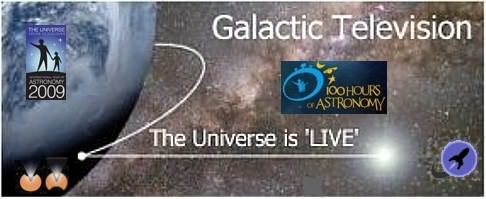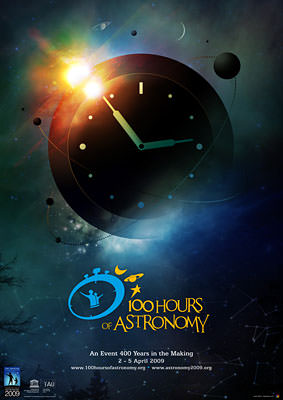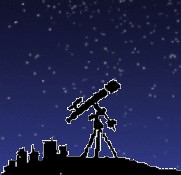Greetings, fellow SkyWatchers! Are you ready to round up the last of the Messier objects as our less frenzied look at the seasonal race continues? While the Moon is back in the early evening skies, what we’re about to hunt down requires getting up early instead of staying up late. I’ll make the coffee and see you in the backyard…
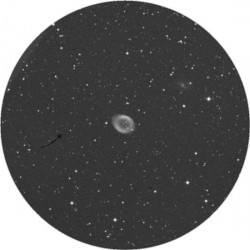 Friday, March 27, 2009 – Are you tired of running the Messier Marathon yet? Don’t be. Up before dawn isn’t everyone’s idea of a good time, but those who enjoy astronomy will enjoy seeing the promise of summer in the stars. For the next several days, we’ll enjoy the finest and most easily located objects as we continue. Start with Lyra and its southernmost two bright stars Beta and Gamma. M57 (RA 18 53 35.08 Dec +33 01 45.0), the Ring Nebula, is about halfway between – the donut with your morning coffee! M56 (RA 19 16 35.50 Dec +30 11 04.2) resides about midway between Gamma Lyrae and Beta Cygni. Two degrees south of Gamma Cygni is open cluster M29 (RA 20 23 56.00 Dec +38 31 23.0), and M39 (RA 21 31 48.00 Dec +48 27 00.0) is less than a fistwidth northeast of Deneb. Hop north of Gamma Sagittae to find M27 (RA 19 59 36.34 Dec +22 43 16.1), and the loose globular M71 (RA 19 53 46.11 Dec +18 46 42.3) is southwest of Gamma.
Friday, March 27, 2009 – Are you tired of running the Messier Marathon yet? Don’t be. Up before dawn isn’t everyone’s idea of a good time, but those who enjoy astronomy will enjoy seeing the promise of summer in the stars. For the next several days, we’ll enjoy the finest and most easily located objects as we continue. Start with Lyra and its southernmost two bright stars Beta and Gamma. M57 (RA 18 53 35.08 Dec +33 01 45.0), the Ring Nebula, is about halfway between – the donut with your morning coffee! M56 (RA 19 16 35.50 Dec +30 11 04.2) resides about midway between Gamma Lyrae and Beta Cygni. Two degrees south of Gamma Cygni is open cluster M29 (RA 20 23 56.00 Dec +38 31 23.0), and M39 (RA 21 31 48.00 Dec +48 27 00.0) is less than a fistwidth northeast of Deneb. Hop north of Gamma Sagittae to find M27 (RA 19 59 36.34 Dec +22 43 16.1), and the loose globular M71 (RA 19 53 46.11 Dec +18 46 42.3) is southwest of Gamma.
Now to early morning skies, and into our galactic halo, as we track down globular clusters. Ophiuchus’ many stars can be hard to identify, so start with Beta Scorpii (Graffias) and head about 10 degrees northeast. That’s Zeta: it’s the marker you’ll need for M107 (RA 16 32 31.91 Dec -13 03 13.1). About one quarter the way back toward Graffias, you will see a line of three stars in the finder. Aim at the center one, and you’ll see globular M10 (RA 16 57 08.99 Dec -04 05 57.6) in the same field, and M12 (RA 16 47 14.52 Dec -01 56 52.2) is 3 degrees northeast. M14 (RA 17 37 36.15 Dec -03 14 45.3) is approximately 16 degrees south and due east of M10.
 Enjoy your day and think about the importance of the birth of John Pierce in 1910. Pierce undertook the visionary work of communications satellites. Although people scoffed at his ideas, in 1960 he convinced a U.S. agency called NASA to convert a balloon-borne experiment called ‘‘Echo’’ into a radio wave reflector. Thanks to his brilliant work, the next step was the development of Telstar, a satellite that ushered in the modern age of television! Of course, you could always just skip TV tonight and do the marathon all at once…
Enjoy your day and think about the importance of the birth of John Pierce in 1910. Pierce undertook the visionary work of communications satellites. Although people scoffed at his ideas, in 1960 he convinced a U.S. agency called NASA to convert a balloon-borne experiment called ‘‘Echo’’ into a radio wave reflector. Thanks to his brilliant work, the next step was the development of Telstar, a satellite that ushered in the modern age of television! Of course, you could always just skip TV tonight and do the marathon all at once…
Saturday, March 28, 2009 – In just a few short days, you’ve conquered 80 objects from a prestigious observing list! The time before dawn is a very quiet and beautiful part of the day. Now head for bright Eta Ophiuchi directly between Scorpius and Sagittarius. Globular M9 (RA 17 19 11.78 Dec -18 30 58.5) is 3.5 degrees southeast. Now head for Antares. The diffuse, giant globular cluster M4 (RA 16 23 35.41 Dec -26 31 31.9) is about a degree west. Four degrees northwest of Antares is compact, bright globular M80 (RA 16 17 02.51 Dec -22 58 30.4). Seven degrees due east of Antares is globular M19 (RA 17 02 37.69 Dec -26 16 04.6)! The last globular cluster this morning is M62 (RA 17 01 12.60 Dec -30 06 44.5), located another 5 degrees south of M19.
Hey, you’re doing terrific! Some of these are tough to find unless you’ve had practice. But now we’re up to a total of 85, and about to add a few more…
The lower curve of Scorpius is quite distinctive and the unaided eye pair you see at the ‘‘stinger’’ is beautiful double Lambda and its slightly less bright neighbor Upsilon. Just northeast is beautiful M6 (RA 17 40 18.00 Dec -32 12 00.0), the Butterfly Cluster. Slightly southeast is an unaided hazy patch. Aim there, and you’ll find spectacular open cluster M7 (RA 17 53 48.00 Dec -34 47 -0.0), or Ptolemy’s Cluster. Identify Lambda Aquilae, look west, and you’ll find M11 (RA 18 51 00.00 Dec -06 16 00.0), the Wild Duck open cluster. About the same distance to the south/southwest is open cluster M26 (RA 18 45 18.66 Dec -09 23 01.0).
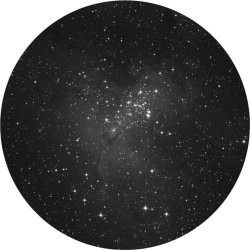 These are all great binocular targets, but it will take an exceptionally dark, clear sky to see the Eagle Nebula associated with M16 (RA 18 18 48.00 Dec -13 49 00.0) – an easy open cluster about a fist-width southwest of M26. If you’re lost, try counting the stars down the Eagle’s back from bright Altair until you reach Gamma Scuti and look about 2 degrees northwest. What you seek is worth the time it takes, because cluster M16 is a star-forming region located on the edge of one of the Milky Way’s own spiral arms about 7,000 light-years away. Perhaps Messier was the first to notice the Eagle Nebula (IC 4703), because his notes include the description: ‘‘enmeshed in a faint glow.’’ Large telescopes can see the dark dust lanes containing the Pillars of Creation, but it isn’t always easy. The entire nebula eluded the Herschels!
These are all great binocular targets, but it will take an exceptionally dark, clear sky to see the Eagle Nebula associated with M16 (RA 18 18 48.00 Dec -13 49 00.0) – an easy open cluster about a fist-width southwest of M26. If you’re lost, try counting the stars down the Eagle’s back from bright Altair until you reach Gamma Scuti and look about 2 degrees northwest. What you seek is worth the time it takes, because cluster M16 is a star-forming region located on the edge of one of the Milky Way’s own spiral arms about 7,000 light-years away. Perhaps Messier was the first to notice the Eagle Nebula (IC 4703), because his notes include the description: ‘‘enmeshed in a faint glow.’’ Large telescopes can see the dark dust lanes containing the Pillars of Creation, but it isn’t always easy. The entire nebula eluded the Herschels!
Don’t forget to shut ’em down tonight from 8:30 to 9:30 pm for Earth Hour. Make your voice heard!
Sunday, March 29, 2009 – Get up before dawn, and let’s take a less frenzied look at the beauty around us. Begin by identifying Lambda, the northernmost star in the teapot asterism of Sagittarius. Its name is Kaus Borealis – the “northern” star – so grab your binoculars, for north is the direction we’re heading…
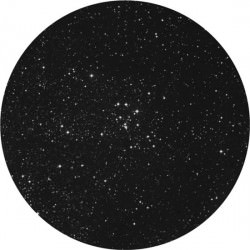 The bright “Nike Swoosh” of M17 is located a fist-width north of Lambda. Many of you know this as the Omega or Swan Nebula. Slide south for a very small collection of stars known as M18 (RA 18 19 58.49 Dec -17 06 07.1). Move further south to call up a huge cloud of stars labeled M24 (RA 18 18 24.00 Dec -18 26 -0.0). This patch of Milky Way “stuff” will also show a wonderful open cluster – NGC 6603 – to average telescopes, and some great Barnard darks to larger ones. Shift southeast for open cluster M25 (RA 18 31 46.77 Dec -19 06 53.9), and head due west a fist-width for open cluster M23 (RA 17 57 00.00 Dec -18 59 -0.0). From there, drop south again, and M21 (RA 18 04 12.00 Dec -22 29 -0.0) will be your reward. M20 (RA 18 02 23.00 Dec -23 01 48.0) – the Trifid Nebula – is southwest. M8 (RA 18 03 37.00 Dec -24 23 12.0) – the Lagoon Nebula – is further south again, and very easy to see. This particular star hop is great fun. If you have children, point out the primary stars, and show them how they look like a dot-to-dot “tea kettle.” From the kettle’s “spout” pours the “steam: of the Milky Way. If you start there, all you will need to do is follow the ‘‘steam’’ trail up the sky and you will see the majority of these with ease. Our Messier temperature has now risen to 98…
The bright “Nike Swoosh” of M17 is located a fist-width north of Lambda. Many of you know this as the Omega or Swan Nebula. Slide south for a very small collection of stars known as M18 (RA 18 19 58.49 Dec -17 06 07.1). Move further south to call up a huge cloud of stars labeled M24 (RA 18 18 24.00 Dec -18 26 -0.0). This patch of Milky Way “stuff” will also show a wonderful open cluster – NGC 6603 – to average telescopes, and some great Barnard darks to larger ones. Shift southeast for open cluster M25 (RA 18 31 46.77 Dec -19 06 53.9), and head due west a fist-width for open cluster M23 (RA 17 57 00.00 Dec -18 59 -0.0). From there, drop south again, and M21 (RA 18 04 12.00 Dec -22 29 -0.0) will be your reward. M20 (RA 18 02 23.00 Dec -23 01 48.0) – the Trifid Nebula – is southwest. M8 (RA 18 03 37.00 Dec -24 23 12.0) – the Lagoon Nebula – is further south again, and very easy to see. This particular star hop is great fun. If you have children, point out the primary stars, and show them how they look like a dot-to-dot “tea kettle.” From the kettle’s “spout” pours the “steam: of the Milky Way. If you start there, all you will need to do is follow the ‘‘steam’’ trail up the sky and you will see the majority of these with ease. Our Messier temperature has now risen to 98…
On this date in 1974, NASA’s Mariner 10 went into history by returning the first close-up pictures of the planet Mercury. Mariner also became the first craft to use solar wind to navigate when its panels were reconfigured into makeshift solar sails! Take time to honor the 1890 birth of Spencer Jones on this date, the first to prove Earth had a slightly irregular rotation, and to triangulate the Sun’s position using an asteroid. Oddly enough, Vesta was also discovered on this date! If you’d like to take a look at this Arizona-sized world for yourself, be sure to look tomorrow night, as it appears less than a fist-width (8 degrees) south of the crescent Moon!
 Monday, March 30, 2009 – Wake up, sleepyhead… You must get up before dawn to finish our Messier studies! While the coffee is brewing, think about the year 239 BC, when the Chinese first recorded a perihelion passage of Halley’s Comet. Now, step outside and look at the starry skies as you pay a moment’s silent tribute to the English astronomer Stephen Groombridge, who passed away on this day in 1832. At age 51, he began cataloging 4,243 circumpolar stars within 50 degrees of Polaris. Although the catalog wasn’t published until 6 years after his death, Groombridge never stopped working on it, even after he founded the Astronomical Society!
Monday, March 30, 2009 – Wake up, sleepyhead… You must get up before dawn to finish our Messier studies! While the coffee is brewing, think about the year 239 BC, when the Chinese first recorded a perihelion passage of Halley’s Comet. Now, step outside and look at the starry skies as you pay a moment’s silent tribute to the English astronomer Stephen Groombridge, who passed away on this day in 1832. At age 51, he began cataloging 4,243 circumpolar stars within 50 degrees of Polaris. Although the catalog wasn’t published until 6 years after his death, Groombridge never stopped working on it, even after he founded the Astronomical Society!
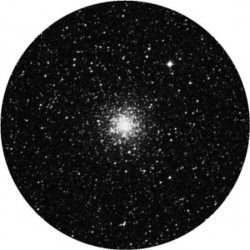 OK, now It’s crunch time, and the first few on this list will be fairly easy to see around 5.00 am, but you won’t have long before the dawn steals them from the sky. Remember Kaus Borealis? Good.
OK, now It’s crunch time, and the first few on this list will be fairly easy to see around 5.00 am, but you won’t have long before the dawn steals them from the sky. Remember Kaus Borealis? Good.
We’re starting at the top of the tea kettle with Lambda, our marker for the small M28 (RA 18 24 32.89 Dec -24 52 11.4) globular cluster. It is just a breath north-northwest. Larger, brighter, and quite wonderful globular cluster M22 (RA 18 36 24.21 Dec -23 54 12.2) is to Lambda’s northeast. The southeastern corner of the tea kettle is Zeta. Slide southwest to capture globular cluster M54 (RA 18 55 03.28 Dec -30 28 42.6). Head another 3 degrees southwest for the faint, fuzzy ball of M70 (RA 18 43 12.64 Dec -32 17 30.8). Two degrees further west is another globular: say good morning to M69 (RA 18 31 23.23 Dec -32 20 52.7)!
You’ve done a fantastic job over the last 10 days, and you can certainly understand by now that even with this slower pace, the Messier Marathon is a challenge not everyone can appreciate. Now, try to get some rest because the last objects on the list are coming up…
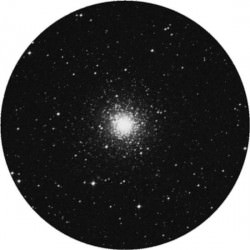 Tuesday, March 31, 2009 – Be warned! It’s really going to get tough to finish our Messier list, but you can do it! Start an hour before sunrise, but don’t procrastinate. Small globular M55 is about a fist-width east-southeast of Zeta Sagittarii, and the dawn is coming. Even more difficult is equally small globular M75 (RA 20 06 04.75 Dec -21 55 16.2). Look for a “V” pattern of stars in the finder a fist-width south of Beta Capricorni, and aim at the northeastern star of this trio. Without the “square” of Pegasus to guide us, look low to the east and identify Enif by its reddish color. The power-punch globular M15 (RA 21 29 58.38 Dec +12 10 00.6) is northwest, and you should be able to see the star on its border in the finderscope. Be thankful M2 (RA 21 33 27.00 Dec -00 49 24.0) is such a fine – and large – globular cluster just a little less than a fist-width due west of Alpha Aquarii.
Tuesday, March 31, 2009 – Be warned! It’s really going to get tough to finish our Messier list, but you can do it! Start an hour before sunrise, but don’t procrastinate. Small globular M55 is about a fist-width east-southeast of Zeta Sagittarii, and the dawn is coming. Even more difficult is equally small globular M75 (RA 20 06 04.75 Dec -21 55 16.2). Look for a “V” pattern of stars in the finder a fist-width south of Beta Capricorni, and aim at the northeastern star of this trio. Without the “square” of Pegasus to guide us, look low to the east and identify Enif by its reddish color. The power-punch globular M15 (RA 21 29 58.38 Dec +12 10 00.6) is northwest, and you should be able to see the star on its border in the finderscope. Be thankful M2 (RA 21 33 27.00 Dec -00 49 24.0) is such a fine – and large – globular cluster just a little less than a fist-width due west of Alpha Aquarii.
Head a fist-width southwest of Beta Aquarii to snag what will now be two extremely dim ones – globular M72 (RA 20 53 27.91 Dec -12 32 13.4) and open cluster M73 (RA 20 59 00.00 Dec -12 38 -0.0) open just west of Nu. We will be just ahead of the light of dawn for our last object. Hang on, Delta Capricorni, and show us the way south-southwest to star 41! If you can find that? Hey… you’ve found the dim globular cluster M30 (RA 21 40 22.03 Dec -23 10 44.6) in the same field northwest.
Congratulations! You’ve done the entire Messier catalog in less than 2 weeks!
Is this a perfect list with perfect instructions? No way. Just like the weather, things aren’t always perfect. These are just general guidelines to help you find the Messiers for yourself. Unless you’re using a computer-guided scope, it takes a lot of practice to find them all, so don’t be discouraged if they don’t just fall from the sky. You might find all of them in 1 year – or you just might find all of them in one good night. Regardless of how long it takes you, or how long it takes the skies to cooperate, the beauty, joy, and reward is the peace and pleasure it brings.
Now, stop and salute the 1966 launch of Luna 10, the first spacecraft to orbit the Moon!
Until next week? Ask for the Moon… But keep on reaching for the stars!
This week’s awesome images in order of appearance are: M57 (credit – Palomar Observatory, courtesy of Caltech), John Pierce (historical image), M16 and the Eagle Nebula (credit- Palomar Observatory, courtesy of Caltech), M18 (credit – Palomar Observatory, courtesy of Caltech), Stephen Groombridge (historical image), M69 and M75 (credit – Palomar Observatory, courtesy of Caltech). We thank you so much!


